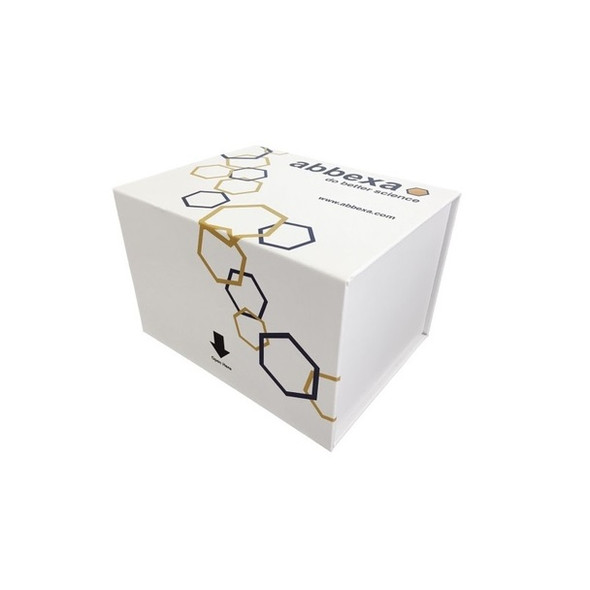Sheep Crimean-Congo hemorrhagic fever virus antibody (CCHF-Ab) ELISA kit | SL00058Sp
- SKU:
- SL00058Sp
- Availability:
- 5 Working days
- Sample Volume:
- 50ul
- Wavelength:
- 450nm
- Qualitative:
- Negative/Positive
Description
Sheep Crimean-Congo hemorrhagic fever virus antibody (CCHF-Ab) ELISA kit | SL00058Sp
This ELISA kit uses Sandwich-ELISA as the method. The Microelisa stripplate providedin this kit has been pre-coated with an antigen specific to CCHF-Ab. Standards or samplesareadded to the appropriate Microelisa stripplate wells and combined to the specific antigen. Then a Horseradish Peroxidase (HRP)-conjugated antigen specific for CCHF is addedtoeachMicroelisa stripplate well and incubated. Free components are washed away. The TMBsubstrate solution is added to each well. Only those wells that contain CCHF-Ab andHRPconjugated CCHF antigen will appear blue in color and then turn yellow after the additionofthe stop solution. The optical density (OD) is measured spectrophotometricallyat awavelength of 450 nm. The presence of CCHF-Ab is determined by comparing withtheCUTOFF value.
Materials provided with the kit

Sample preparation
- Serum preparation
After collection of the whole blood, allow the blood to clot by leaving it undisturbed at room temperature. This usually takes 10-20 minutes. Remove the clot by centrifuging at 2,000-3,000 rpm for 20 minutes. If precipitates appear during reservation, the sample should be centrifugated again.
- Plasma preparation
Collect the whole blood into tubes with anticoagulant (EDTA or citrate). After incubated at room temperature for 10-20 minutes, tubes are centrifugated for 20 min at 2,000-3,000 rpm. Collect the supernatant carefully as plasma samples. If precipitates appear during reservation, the sample should be centrifugated again.
- Urine samples
Collect urine into aseptic tubes. Collect the supernatant carefully after centrifuging for 20 min at 2,000-3,000 rpm. If precipitates appear during reservation, the sample should be centrifugated again. The preparation procedure of cerebrospinal fluid and pleuroperitoneal fluid is the same as that of urine sample.
- Cell samples
If you want to detect the secretions of cells, collect culture supernatant into aseptic tubes. Collect the supernatant carefully after centrifuging for 20 min at 2,000-3,000 rpm. If you want to detect intracellular components, dilute the cells to 1X100/ml with PBS (pH 7.2-7.4). The cells were destroyed to release intracellular components by repeated freezing and thawing. Collect the supernatant carefully after centrifuging for 20 min at 2,000-3,000 rpm. If precipitates appear during reservation, the sample should be centrifugated again.
- Tissue samples
Tissue samples are cut, weighed, frozen in liquid nitrogen and stored at -80℃ for future use. The tissue samples were homogenized after adding PBS (pH 7.4). Samples should be operated at 4℃. Collect the supernatant carefully after centrifuging for 20 min at 2,000-3,000 rpm. Aliquot the supernatant for ELISA assay and future use.
Notes:
- Sample extraction and ELISA assay should be performed as soon as possible after sample collection. The samples should be extracted according to the relevant literature. If ELISA assay can not be performed immediately, samples can be stored at -20℃.Repeated freeze-thaw cycles should be avoided.
- Our kits can not be used for samples with NaN3 which can inhibit the activity of HRP.
Procedure
1. In the Microelisa stripplate, leave two wells as negative control, two wells as positivecontrol and one well empty as as blank control. Number: the sequential number, corresponding sample of the microporous hole 2 per board should set negative control
and positive control 2 holes, ck 1 hole (ck hole without samples and HRP-Conjugatereagent, the rest of the same step operation)
2. Adding samples: Negative and positive control in a volume of 50μl are addedtothenegative and positive control wells respectively. In sample wells, 40μl Sample dilution
5buffer and 10μl sample are added. Samples should be loaded onto the bottomwithout
touching the well wall. Mix well with gentle shaking.
3. Incubation: incubate 30 min at 37℃ after sealed with Closure plate membrane.
4. Dilution: dilute the concentrated washing buffer with distilled water (30 times for 96T).
5. Washing: carefully peel off Closure plate membrane, aspirate and refill with thewashsolution. Discard the wash solution after resting for 30 seconds. Repeat the washingprocedure for 5 times.
6. Add 50 μl HRP-Conjugate reagent to each well except the blank control well.
7. Incubation as described in Step 3.
8. Washing as described in Step 5.
9. Coloring: Add 50 μl Chromogen Solution A and 50 μl Chromogen Solution Btoeachwell, mix with gently shaking and incubate at 37℃ for 15 minutes. Please avoidlight
during coloring.
10. Termination: add 50 μl stop solution to each well to terminate the reaction. The color inthe well should change from blue to yellow.
11. Read absorbance O.D. at 450nm using a Microtiter Plate Reader. The ODvalue of theblank control well is set as zero. Assay should be carried out within 15 minutes afteradding stop solution.
Determine the result
Test effectiveness: the average value of positive control ≥1.00; the average valueofnegative control ≤0.10. The critical value (CUT OFF) calculation: critical value = the average value of negativecontrol + 0.15
Negative judgement: if the OD value< CUT OFF, the sample is Sheep CCHF-Ab negative. Positive judgement: if the OD value ≥CUT OFF, the sample is Sheep CCHF-Ab positive.
Notes
2.Store the kit at 4°C upon receipt.The kit should be equilibrat4ed to roomtemperature
before the assay. Remove any unneeded strips from CCHF antigen -Coated plate, reseal
them in zip-lock foil and keep at 4°C.
3.Precipitates may appear in concentrated washing buffer. Please heat the buffer todissolveall the precipitates, which will not affect the results.
4.In order to avoid cross-contamination, Closure plate membranes are for one-time useonly.
5.Please keep Substrate away from light.
6.All the operation should be accordance with the manufacturer's instructions strictly. Theresults determined by the Microelisa stripplate Reader.
7.All the samples, washing buffer and wastes should be treated as infectious agents.
8.Reagents from different lots should not be mixed.
Storage and validity
1.Storage: 2-8℃. 2.Duration: 6 months









